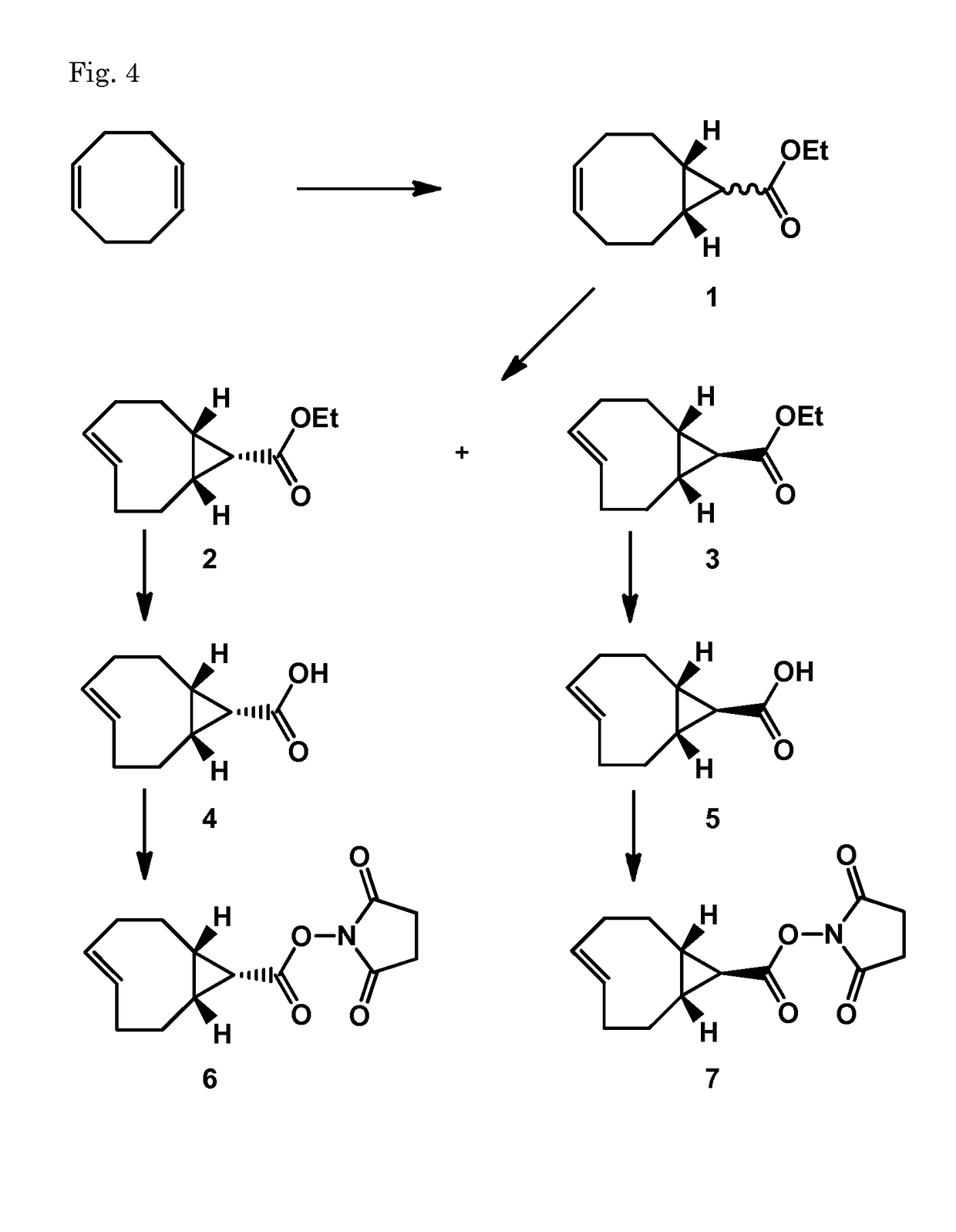Pretargeting kit for imaging or therapy comprising a trans-cyclooctene dienophile and a diene
a diene and kit technology, applied in the field of pretargeting methods, can solve the problems of pre-targeting approaches, inaccessible to patients, and usually small probes
- Summary
- Abstract
- Description
- Claims
- Application Information
AI Technical Summary
Problems solved by technology
Method used
Image
Examples
example 1
Synthesis of (E-endo)-2,5-dioxopyrrolidin-1-yl bicyclo[6.1.0]non-4-ene-9-carboxylate (6) and (E-exo)-2,5-dioxopyrrolidin-1-yl bicyclo[6.1.0]non-4-ene-9-carboxylate (7)
[0192]Compound 1 was synthesized following Dommerholt et al. Angew. Chem. Int. Ed. 2010, 49, 9422-9425
(Z)-ethyl bicyclo[6.1.0]non-4-ene-9-carboxylate (1)
[0193]To a solution of 1,5-cyclooctadiene (18.5 mL, 150 mmol) and rhodium(II)acetate dimer (cat. amount) in CH2Cl2 (10 mL) was added slowly a solution of 15% ethyl diazoacetate (2.0 mL, 18.8 mmol) in CH2Cl2 (20 mL) over a period of 3.5 h while cooling in an icebath. After addition the reaction mixture was warmed to RT. After 1.5 h the reaction was complete according to NMR analysis and the mixture was filtered over a silicagel plug and washed with CH2Cl2. The filtrate was concentrated until all CH2Cl2 was removed and then diluted with heptane. The solution was eluted over a filter with silicagel with heptane (500 mL) and with MTBE (400 mL). The MTBE fraction contained ...
example 2
Antibody Modification with endo- and exo-E-2,5-dioxopyrrolidin-1-yl bicyclo[6.1.0]non-4-ene-9-carboxylate (6 and 7)
[0201]A solution of CC49 (5 mg / mL, 250 μL) in PBS was modified with 1 or 10 molar eq. of TCO—NHS (6 or 7, 10 mg / mL solution in DMSO) in a total volume of 500 μL PBS. The pH was adjusted to 9 with 1 M sodium carbonate buffer. The reactions were carried out under agitation for 30 min at RT in the dark. Subsequently, the TCO-modified mAbs were extensively washed with PBS using Amicon Ultra-15 centrifugal devices. At the end of the conjugation procedure the purity and integrity of the CC49-TCO conjugates were assessed by SEC-HPLC and SDS-PAGE analysis (FIGS. 6 and 7). The conjugation yields were determined with tetrazine titrations. The TCO-modified mAbs (25 μL) were reacted with a known excess of carrier-added 177Lu-DOTA-tetrazine in PBS (50 μL). After 10 min incubation at 37° C., the reaction mix were added with non-reducing sample buffer, boiled for 10 min and analyzed b...
example 3
Measurements of Reaction Kinetics Between Tetrazine and mAb-Conjugated endo- and exo-E-2,5-dioxopyrrolidin-1-yl bicyclo[6.1.0]non-4-ene carboxylate (6 and 7)
[0202]Tetrazine-DOTA 8 (FIG. 5) was radiolabeled with carrier-added 177Lu at a specific activity of 8 MBq / μg. 177Lu-DOTA-tetrazine (0.67 nM) was reacted with increasing concentrations of CC49 modified with 0.4 or 0.7 eq. of endo and exo TCO (6 and 7) in 1 mL PBS, pH 7.4, at 37° C. At selected times (15, 30, 45, 60, 90 and 120 sec) a 20 μL sample was withdrawn and the reaction was quenched with tetrazine derivative 9 (3 μL, 1 mg / mL in DMF). The samples were then added with non-reducing sample buffer, boiled for 10 min and analyzed by SDS-PAGE. After gel electrophoresis, the radioactivity distribution in each lane was assessed with phosphor imager. The reaction yields between 177Lu-DOTA-tetrazine and the CC49-TCO constructs were estimated from the intensity of the radioactive mAb band with respect to the total radioactivity in the...
PUM
| Property | Measurement | Unit |
|---|---|---|
| time | aaaaa | aaaaa |
| time period | aaaaa | aaaaa |
| time period | aaaaa | aaaaa |
Abstract
Description
Claims
Application Information
 Login to View More
Login to View More - R&D
- Intellectual Property
- Life Sciences
- Materials
- Tech Scout
- Unparalleled Data Quality
- Higher Quality Content
- 60% Fewer Hallucinations
Browse by: Latest US Patents, China's latest patents, Technical Efficacy Thesaurus, Application Domain, Technology Topic, Popular Technical Reports.
© 2025 PatSnap. All rights reserved.Legal|Privacy policy|Modern Slavery Act Transparency Statement|Sitemap|About US| Contact US: help@patsnap.com



